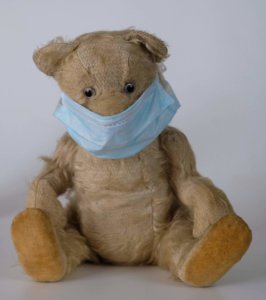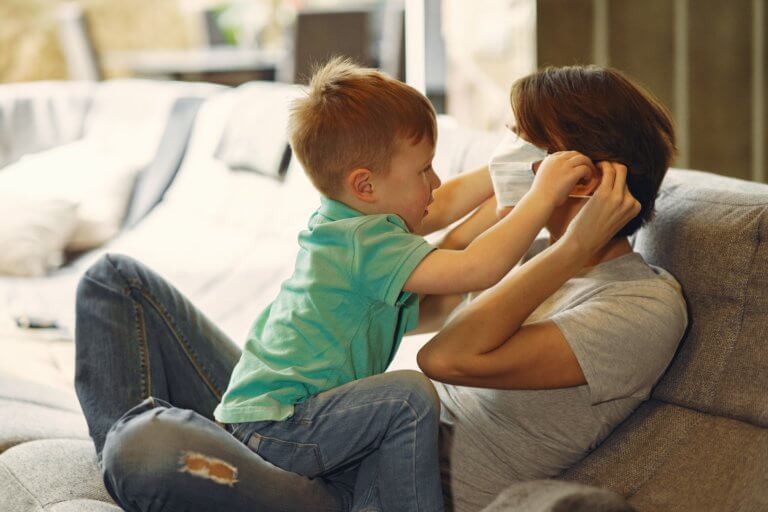As restrictions are slowly starting to be lifted, it may soon be possible to begin taking our children out to more places again. But, one big difference seems to be here to stay (at least for now): wearing masks. It is still the current CDC recommendation that children over the age of 2 (and adults) wear cloth masks when out in public. But masks make the world much more confusing for children. Adults may look scary because it is harder to see friendly facial expressions or to distinguish parents from strangers. It is harder to hear and understand directions due to our muffled voices. Not to mention the unfamiliar feeling of wearing one!
As wearing a mask is quickly becoming a new key activity of daily living, I have put together these helpful tips for families. These tips are intended to help kids feel more comfortable both with seeing masks on adults, as well as wearing a mask themselves. Please note that there are exceptions to wearing masks for certain medical conditions, so please consult your doctor if you are unsure if it is safe for you or your child to wear a mask.
1. Wearing masks is fun
Introduce masks in a fun, age-appropriate way. Put a mask on a stuffed animal, or incorporate a mask into a Halloween costume. Take funny pictures while wearing masks. There are also now several shops making child-sized masks with fun themes that may help your child be more excited to wear them. Each child having their own design according to their interests can give them a sense of ownership and pride in their masks. If you aren’t able to access pre-made themed masks, feel free to customize your existing fabric masks! Use permanent marker or fabric pens to individualize your family’s masks.

2. Masks aren't scary
One source of anxiety in children is that they will not be able to recognize you when you are out if you’re wearing a mask. This reinforces the concept of individualizing your masks. Having your own distinctive mask pattern that they will be able to identify can help ease this. You may also consider a mask that has a clear panel if your child is especially distressed by not seeing your full face. These particular masks also benefit those who are hearing impaired.
3. See me wear my mask

Demonstrating can help show children that wearing a mask isn’t so scary, as well as help them become used to what you look like when wearing a mask. Draw attention to what your eyes look like when you’re smiling under the mask. Begin a new routine of visibly putting the mask on to leave the house, even if it’s just to get the mail or to take the trash out. While these activities do not necessarily require the mask for safety, consistency in modeling will help your child understand that a mask will be needed when leaving the house.
4. Let's practice together
Slowly introduce your child to wearing their mask. Make sure it fits them as comfortably as possible. Begin with only a minute or two, and help them understand the new sensation of breathing inside a mask. Encourage them to take a few breaths to help them realize that they are still able to breathe normally, even though it does not feel like it at first. After they are able to tolerate a minute or two at a time, build up to playing a short card game or watching an episode of a TV show with the mask on. Engaging in a fun activity with a mask on will help your children become used to the mask with as little stress as possible. Finally, every time your child is putting their mask on, put yours on too.
5. Troubleshooting
For children who need extra help preparing for change or understanding new things: consider using a social story like this one by Autism Little Learners.
For children who do not like the feeling of the mask behind their ears: Find a headband or hat that they like to wear, and sew large buttons on each side to loop the elastic around.
For children who especially dislike the constricted feeling of masks over their nose and mouth: Consider the design you purchase or make. Many have found that the rounded style with the middle seam (rather than the pleated style) provides more room and are not as tight on the nose. Try to choose the softest fabric possible.
For children who become distressed when trying to wear a mask: Stay calm, give them more time, and go back to the early steps listed above. Try not to let the mask become a negative experience.
I don’t think any of us are thrilled with wearing masks when we are out. But, I think all of us are eager to at least be able to take steps toward slowly and safely returning to normalcy.
If you have any specific questions about how to help your child become more comfortable with masks, do not hesitate to contact us for a free phone consultation with our occupational therapist. We are here to help.

